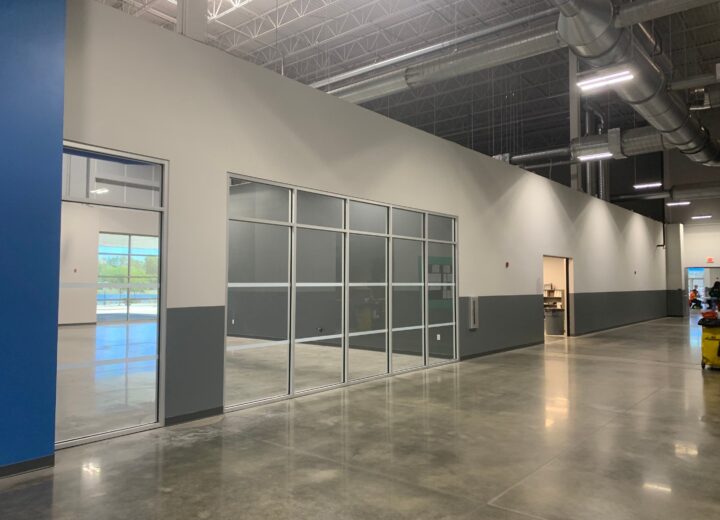One of the biggest challenges associated with painting operations in confined environments is that these spaces can be difficult or impossible to exit if something goes wrong. To avoid confined space-related incidents, the industrial painters enlisted to work in these spaces should have proper credentials.

When industrial painters enter a confined space, they are exposed to a variety of potential hazards that may result from toxic chemicals, industrial solvents, and electrical equipment or machinery that could start up unexpectedly.
To prevent confined space-related accidents and injuries, let’s find out what a confined space is and how it can be made safe.
What Constitutes a Confined Space?
By definition, a confined space is any enclosed or partially enclosed space that has restricted or limited means of entry and/or exit. Additionally, a confined space must be large enough for workers to enter fully in order to perform the tasks assigned. Industrial smokestacks, silos, cooling towers, tunnels, bins, storage tanks, and ship compartments are just a few examples of confined spaces.
When it comes to confined environments, there are two main categories of hazards industrial painting contractors may face:
- Hazardous atmospheres: A hazardous atmosphere refers to any materials or chemicals in the form of dust, vapor, or fumes that affect the air in a space. Depending on the type and extent of exposure, certain substances can increase the risk of fire or explosion and impair workers’ ability to think clearly, coordinate movement, and escape unaided from confined spaces. As an example, flammable or explosive gases, industrial solvents, and depleting-oxygen substances that may result from different stored materials and painting operations can accumulate in an enclosed space and create a hazardous atmosphere.
- Physical hazards: Physical hazards in confined spaces are the ones that cause bodily injuries. Examples include access problems, falling objects, illumination problems, elevated noise levels, slippery surfaces, extreme temperatures, materials that could trap workers, and equipment that could start and move unexpectedly.
Safety Precautions in Confined Spaces
In order to recommend adequate safety measures, a risk assessment of each confined space should be carried out by competent and qualified professionals.
Based on the hazards identified and the threat severity they pose, the professionals will indicate a series of precautions and procedures that should be carefully considered and implemented before workers are allowed to enter a confined space.
As a general rule, the following control measures can minimize exposure to hazards in enclosed environments.
- Industrial painters should be appropriately trained for working in confined spaces; inexperienced staff should be regularly reminded of the safety precautions they need to implement during each task;
- Painters must be informed about all the existing and potential hazards in confined environments;
- Workers must be in a suitable physical condition for the work they need to perform; if there are any concerns about the physical condition of a worker, he should not be allowed to enter a confined space;
- Dangerous substances, materials, and/or equipment should be eliminated, controlled, or isolated when possible in order to minimize or prevent worker exposure;
- Site supervisors must arrange for safe access and escape in and from confined spaces, including an emergency exit (e.g. a second ladder, versatile rescue systems, etc.), where possible;
- All painters must be trained in the proper use of PPE and wear adequate equipment properly (including respirators and self-contained breathing apparatus) at all times;
- Additional equipment and devices should be made available (e.g. multi-gas detection devices that read oxygen levels and detect toxic and flammable substances, electronic sensors that alert workers at the first signs of hazards, so they have enough time to evacuate, etc.);
- A confined space should be equipped with forced-air ventilation systems; these systems are effective at keeping temperatures at safe levels and controlling hazardous atmospheres by maintaining airflow and replacing contaminated air with ambient air from outside the enclosed area;
- Adequate lighting arrangements should be set up for painters to have clear vision while working;
- Continuous monitoring of the work site and potential hazards should be ensured in order to prevent unauthorized personnel from entering the space;
- An emergency response rescue team that could reach the work site within a reasonable amount of time following a confined space-related incident should be available; an attendant should also remain near the opening of the space to constantly monitor the area for hazards and stay in communication with the painters working in the confined space;
- The space should be reevaluated if the conditions change.
The implementation of these precautions and procedures is a good starting point for ensuring the safety of painting operations in confined environments. However, if the work can be done externally or remotely, there isn’t any reason to transform a simple paint job into a difficult one. After all, the elimination of potential hazards is the best strategy for ensuring everyone’s safety during industrial painting operations.






